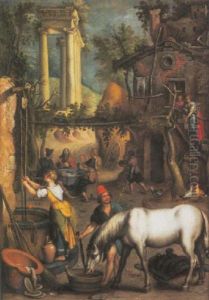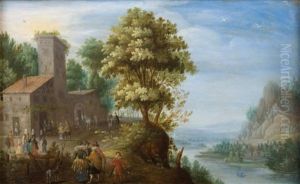Pieter Stevens Paintings
Pieter Stevens was a Flemish landscape painter and draughtsman, known for his innovative treatment of landscape painting during the late 16th and early 17th centuries. The exact date and place of Stevens's birth are not precisely known, but he is believed to have been born around 1567. There is very little known about his early life or training, but he is thought to have been active in the Southern Netherlands (modern-day Belgium).
Stevens's work was strongly influenced by the Mannerist style, which was popular in the late Renaissance. This style is characterized by its artificial and elongated figures, vibrant colors, and intricate compositions. He was particularly influenced by the work of fellow Flemish artist Paul Bril, who was renowned for his landscape paintings.
In 1590, Stevens traveled to Prague, where he joined the court of Rudolf II, Holy Roman Emperor. Rudolf II was a great patron of the arts, and his court attracted many of the finest artists of the day. While at the court, Stevens produced numerous landscape drawings and paintings, many of which depicted the Bohemian countryside. His landscapes often included fantastical elements, such as exotic animals and mythical creatures, reflecting the emperor's taste for the wondrous and the curious. Stevens's works from this period show a keen interest in naturalistic detail and atmospheric effects, which would become hallmarks of his style.
The date of Stevens's death is not well-documented, but he is believed to have died after 1624. Although he did not achieve the same level of fame as some of his contemporaries, Stevens's work has been recognized for its contribution to the development of landscape painting in Europe. His ability to capture the subtleties of light and atmosphere influenced later generations of artists, and his inventive compositions helped to broaden the scope of possibilities within the landscape genre.
Stevens's work is held in several major art collections, and although not as widely known as some of his peers, his contributions continue to be appreciated by art historians and connoisseurs of the Mannerist style. His legacy is that of an artist who was able to blend detailed natural observations with the imaginative and fantastical elements that appealed to the sensibilities of his era.




























